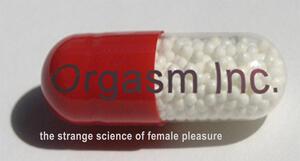Yet to come: Orgasm Inc. and the invention of female sexual dysfuntion
Last night I saw Orgasm Inc., a documentary film by Liz Canner about the medicalization of female sexual pleasure and the race to find a cure for so-called "female sexual dysfunction."
Orgasm Inc. was produced by Chicken and Egg Pictures, a hybrid film fund and production company that provides money and mentorship to women filmmakers making socially conscious films. Chicken and Egg's co-founder Judith Helfand, who is an executive producer of the film, is featured in JWA's feature on Jewish Women in Environmental Activism.
The culmination of nine years of research and documentation, Orgasm Inc. tells a disturbing story. It began with a statistic: 43% of women have some form of sexual dysfunction. This was originally reported in a medical journal, and then exploded across America, touted as proof of a "secret epidemic" affecting women. The statistic was based on the results of a simple survey where women were asked yes or no questions about their experience of sex, like "Do you achieve orgasm?" or "Do you have trouble lubricating?" With that survey, “female sexual dysfunction,” or FSD was born. And with the legitimization of FSD as a medical disease, the race was on for pharmaceutical companies to find, and market, a cure.
Drug companies began by testing whether Viagra, or other drugs that work by increasing blood flow to the genitals, would work for women like they work for men. It turns out that provoking female sexual pleasure is a bit more complicated than causing an erection.
Orgasm, Inc. looks closely at the implications of marketing a drug for FSD. Companies are experimenting with different types of hormone therapy, which is worrisome considering what we now know about the dangerous of taking hormone replacement therapy. Another supposed treatment for FSD is vaginoplasty, a surgical procedure to tighten the vaginal muscles. Of course, the clinics that offer vaginoplasty usually offer labiaplasty – usually considered a purely cosmetic procedure. Both of these procedures come with considerable risk.
What I found most interesting about the film was the parallel made to female hysteria in the Victorian era. No longer a medical diagnosis, women who seemed restless, irritable, stressed, or generally unsatisfied (troublemakers) were diagnosed with hysteria. The treatment included "pelvic massage, " or manual stimulation of the genitals by the doctor until the patient experienced “hysterical paroxysm,” or orgasm. Hmmm.
In the 19th century, hysteria was thought to be caused by “stresses of modern life,” perhaps referring to the stress of being educated enough to desire fulfillment outside the home. Women with hysteria were not supposed to read. Instead they received medical treatment. Is FSD the contemporary hysteria? Is it a medical disease or simply the sexual frustration of women raised without an understanding of their own bodies and healthy sexuality? Are we, once again, turning to medicine in order to “cure” women of their frustration to avoid educating and empowering them to explore and determine their own sexuality?
In the film, Liz Canner starts to get at other possible explanations for why women cannot orgasm. Interviewing a sexual assault survivor and an over-worked wife and mother, Canner suggests that trouble with sex may not always be physiological. In what is perhaps the most emotional interview of the film, she talks to a woman who is ashamed because she can’t orgasm from regular intercourse, which she believes is the “normal” way since that’s how it happens in the movies. Even though she can orgasm from other acts, she thinks she is “diseased” because she can’t do it the “normal” way. By the end of the film, she is dancing around happily, ecstatic to have learned that most women have trouble reaching orgasm from intercourse alone and she is, in fact, normal. It makes you wonder how many cases of FSD could be cured with a copy of Our Bodies, Ourselves, or The Guide to Getting it On.
Orgasm Inc. is an important film. Each day the pharmaceutical industry gets closer to FDA approval for the “female Viagra.” When that day comes, otherwise healthy women will be diagnosed, treated, and exposed to any number of health risks and side effects. And even if a drug does meet FDA approval, I’m not convinced it will do much to improve women’s sex lives. After all, sexuality is not a matter of genital biology. It’s a lot more complicated.
There are ways to fight back. Check out the New View campaign to get involved. To learn more about the legacy of Jewish women and health activism, visit Jewish Women: A Comprehensive Historical Encyclopedia.







